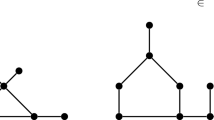Abstract
In this paper we explore an interesting relationship between discrete-time quantum walks and the Ihara zeta function of a graph. The paper commences by reviewing the related literature on the discrete-time quantum walks and the Ihara zeta function. Mathematical definitions of the two concepts are then provided, followed by analyzing the relationship between them. Based on this analysis we are able to account for why the Ihara zeta function can not distinguish cospectral regular graphs. This analysis suggests a means by which to develop zeta functions that have potential in distinguishing such structures.
Similar content being viewed by others
References
Aharonov, D., Ambainis, A., Kempe, J., Vazirani, U.: Quantum walks on graphs. In: STOC’01: Proceedings of ACM Theory of Computing, pp. 50–59. ACM Press, New York (2001)
Ambainis A.: Quantum walks and their algorithmic applications. Int. J. Quantum Inf. 1, 507–518 (2003)
Ambainis, A., Bach, E., Nayak, A., Vishwanath, A., Watrous, J.: One-dimensional quantum walks. In: Proceedings of 33th STOC, pp. 60–69. New York, NY, ACM, NewYork (2001)
Bass H.: The Ihara-Selberg zeta function of a tree Lattice. Int’l J. Math. 6, 717–797 (1992)
Cameron P.J.: Strongly Regular Graphs. Topics in Algebraic Graph Theory, pp. 203–221. Cambridge University Press, Cambridge (2004)
Childs A.M., Farhi E., Gutmann S.: An example of the difference between quantum and classical random walks. Quantum Inf. Process. 1(1/2), 35–43 (2002)
Childs A.M.: Universal computation by quantum walk. Phys. Rev. Lett. 102(18), 180501 (2009)
Douglas B.L., Wang J.B.: A classical approach to the graph isomorphism problem using quantum walks. J. Phys. A Math. Theor. 41(7), 075303 (2008)
Emms, D., Hancock, E.R., Severini, S., Wilson, R.C.: A matrix representation of graphs and its spectrum as a graph invariant, Electronic J. Combinatorics 13(R34), (2006)
Emms, D.: Analysis of Graph Structure Using Quantum Walks, Ph.D. Thesis, University of York (2008)
Emms D., Severini S., Wilson R.C., Hancock E.R.: Coined quantum walks lift the cospectrality of graphs and trees. Pattern Recognit. 42(9), 1988–2002 (2009)
Gamble J.K., Friesen M., Zhou D., Joynt R., Coppersmith S.N.: Two-particle quantum walks applied to the graph isomorphism problem. Phys. Rev. A 81(5), 52313 (2010)
Grover, L.: A fast quantum mechanical algorithm for database search. In: Proceedings of the 28th Annual ACM Symposium on the Theory of Computation, pp. 212–219. New York, NY, ACM Press, New York (1996)
Hashimoto K.: Artin-type L-functions and the density theorem for prime cycles on finite graphs. Adv. Stud. Pure Math. 15, 211–280 (1989)
Ihara Y.: On discrete subgroups of the two by two projective linear group over P-adic fields. J. Math. Soc. Jpn. 18, 219–235 (1966)
Kempe J.: Quantum random walks—an introductory overview. Contemp. Phys. 44(4), 307–327 (2003)
Konno N.: One-dimensional discrete-time quantum walks on random environments. Quantum Inf. Process. 8(5), 387–399 (2009)
Kotani M., Sunada T.: Zeta functions of finite graphs. J. Math. Sci. Univ. Tokyo 7(1), 7–25 (2000)
Scott G., Storm C.: The coefficients of the Ihara zeta function. Involve A J. Math. 1(2), 217–233 (2008)
Shankar R.: Principles of Quantum Mechanics. 2nd edn. Plenum, New York (1994)
Shiau S.-Y., Joynt R., Coppersmith S.N.: Physically-motivated dynamical algorithms for the graph isomorphism problem. Quantum Inform. Comput. 5(6), 492–506 (2005)
Stark H.M., Terras A.A.: Zeta functions of finite graphs and coverings. Adv. Math. 121, 124–165 (1996)
Stark H.M., Terras A.A.: Zeta functions of finite graphs and coverings, II. Adv. Math. 154, 132–195 (2000)
Stark H.M., Terras A.A.: Zeta functions of finite graphs and coverings, III. Adv. Math. 208(2), 467–489 (2007)
Author information
Authors and Affiliations
Corresponding author
Rights and permissions
About this article
Cite this article
Ren, P., Aleksić, T., Emms, D. et al. Quantum walks, Ihara zeta functions and cospectrality in regular graphs. Quantum Inf Process 10, 405–417 (2011). https://doi.org/10.1007/s11128-010-0205-y
Received:
Accepted:
Published:
Issue Date:
DOI: https://doi.org/10.1007/s11128-010-0205-y




